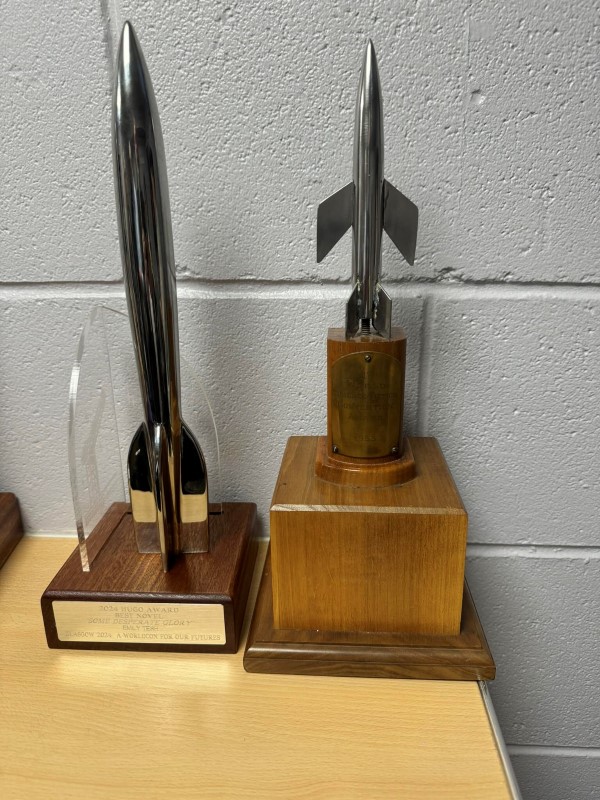Hugo Trophy Designs
The earliest Hugo Award trophy used a rocket designed by Jack McKnight and Ben Jason based upon the hood ornament from a 1950s American automobile; however, the shape of the rocket changed over the years as individual committees reinterpreted the design. The current design of the trophy rocket, which is now considered definitive, has been the same since British fan Peter Weston’s refinement of the design debuted in 1984. Since then, every Hugo Award trophy rocket (except those used in 1991) has been literally cast from the same mold by Ashwater Foundry in England.
Each Worldcon Committee designs a base for the trophy. Some have been fairly plain; others have moved toward the fanciful and whimsical. The 1992 Hugo Award, presented by MagiCon, included pieces of an actual gantry from NASA’s Kennedy Space Center, while the 1994 Hugo Award, presented by ConAdian, contained pieces of “space metal” — pieces of Canadian sounding rockets that had actually been in space.
A full archive of all historic Hugo designs can be found in the trophy gallery on the official Hugo Awards website.
There is also an article by Peter Weston describing how the rockets are actually made.
2024 Trophy Designs
The Glasgow 2024 Hugo Award Base has been designed by Iain J. Clark. The trophy for the 2024 Lodestar Award for Best YA Book has been designed
This page has full details of this year’s designs.
The First Hugo
The first Hugo Awards were given out at the 11th World Science Fiction Convention, which took place at the Bellevue-Stratford Hotel in Philadelphia on 5-7 September 1953. Although the Awards were conceived as a one-off event, they proved so popular that organizers, having skipped handing them out during the 12th Worldcon, reinstated them in 1955 and thereafter made them a tradition.
The very first award was issued to Forrest J. Ackerman for being the #1 Fan Personality. History records that immediately after he was handed the trophy, Ackerman declined it in favor of Ken Slater and abandoned the little rocket-shaped trophy on stage to be forwarded to Britain. The trophy went back to Ackerman’s collection when Ken passed away, and was then sold again after Ackerman’s own death. The trophy came up for auction in 2024 where it was purchased by the Worldcon Heritage Organisation on behalf of Worldcon and fandom. More information is available in this File770 article.
The Ackerman Hugo was displayed at Glasgow 2024 in its first Worldcon appearance since 1953, where it was greatly admired and appreciated by the attendees.

Previous Glasgow Worldcons
The 1995 (Intersection) Hugo Award base was designed by Sylvia Starshine. The design comprised layers of granite, steel, and glass to reflect Glasgow’s engineering and technology history.

The 2005 (Interaction) Hugo Award base was designed by Deb Kosiba. Following from the visual branding used in the convention’s promotional campaigns, it was inspired by the works of Glasgow designer Charles Rennie Mackintosh.

